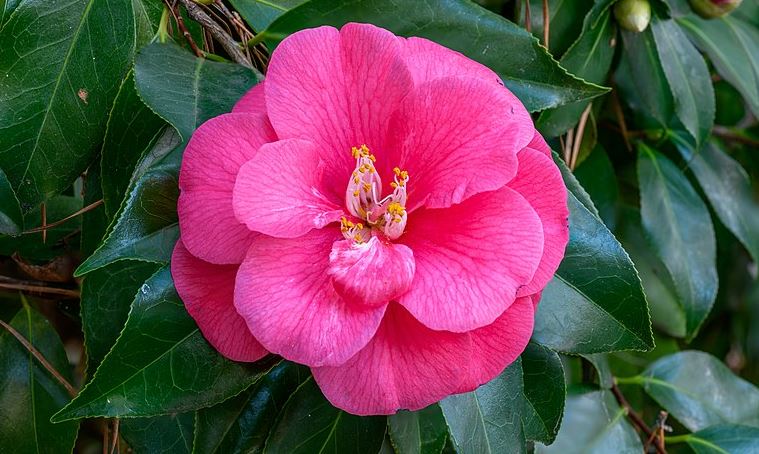
Camellia japonica, commonly known as the Japanese camellia, is native to Japan, Korea, and parts of China. It was first introduced to the West in the early 18th century by Georg Joseph Kamel (after whom the genus Camellia is named), although it was Engelbert Kaempfer who first described it from Japan.
In Japan, the camellia has been cultivated for centuries, not only for its beauty but also for practical uses like the oil extracted from its seeds. It has symbolic meaning in various cultures, often representing love, affection, or admiration. In the Victorian language of flowers, camellias conveyed a notion of excellence or beauty. The plant reached Europe in the 1700s and became highly popular in the 19th century during the Romantic period when exotic plants from the East were in vogue.
Characteristics
- Leaves: The foliage of Camellia japonica is evergreen, with glossy, dark green leaves that have a leathery texture.
- Flowers: Perhaps its most striking feature, the flowers can range from white through various shades of pink to deep red, and even variegated. The blooms can be single, semi-double, anemone, peony, or formal double in form. They typically appear in late winter to early spring, providing color when few other plants are in bloom.
- Size: It can grow into a large shrub or small tree, typically reaching heights of 6 to 12 feet, though some can grow taller under ideal conditions.
- Growth Habit: It has a bushy, upright growth habit but can be trained into tree form or used in espalier.
Cultivation
- Climate: Camellia japonica prefers temperate climates with mild summers. It thrives in USDA zones 7-9, though some cultivars have been bred for greater cold hardiness.
- Soil: They require well-drained, acidic soil rich in organic matter. Soil pH should ideally be between 5.5 and 6.5.
- Light: Partial shade is ideal, protecting the plant from intense afternoon sun, which can scorch the leaves. However, they need enough light to bloom well.
- Watering: Regular watering is necessary, especially during dry spells, but the plant should not sit in waterlogged soil.
- Pruning: Pruning can be done after flowering to shape the plant or remove dead or weak wood. However, over-pruning can reduce flowering.
- Pests and Diseases: Common issues include tea scale, aphids, and camellia petal blight. Proper air circulation and avoiding overhead watering can help prevent fungal issues.
- Mulching: A good layer of mulch helps to retain moisture, regulate soil temperature, and reduce weed competition.
- Fertilization: Use a fertilizer formulated for acid-loving plants in spring after blooming and possibly once more in the summer, but avoid over-fertilization.
- Propagation: Camellia japonica can be propagated by seeds, cuttings, grafting, or air layering, with cuttings and grafting being the most common for maintaining cultivar characteristics.